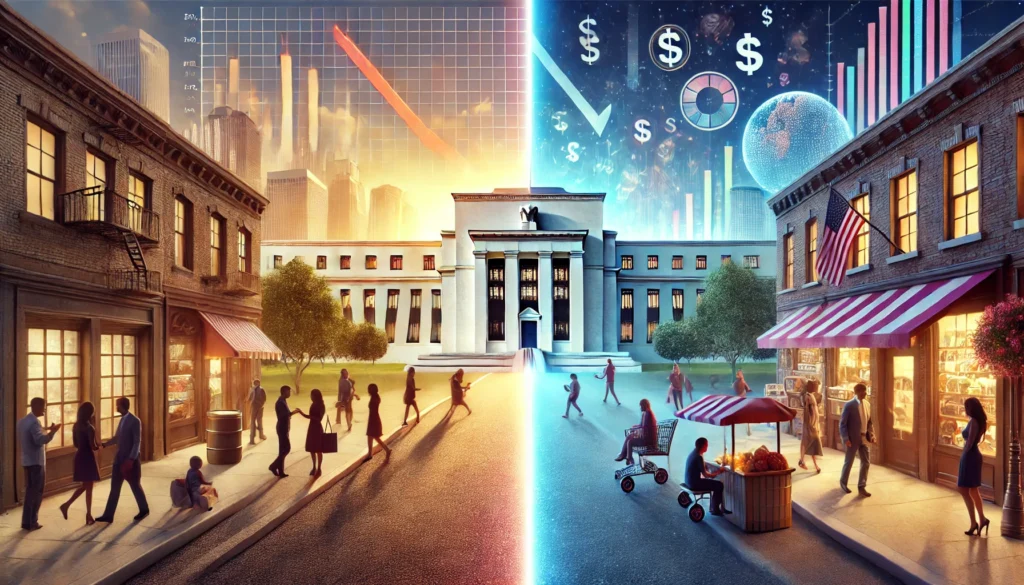The Resilient Economy: How Recent Data Signals a Brighter Outlook Amid Recession Fears

|
Getting your Trinity Audio player ready...
|
Unpacking the Latest Economic Indicators and What They Mean for the Future
A Glimmer of Hope Amid Uncertainty
In the early months of 2024, the U.S. economy teetered on the brink of uncertainty. Headlines warned of a looming recession, inflation continued its relentless march, and the Federal Reserve’s aggressive rate hikes seemed to cast a shadow over any potential growth. For small business owners, families, and investors alike, the future felt precarious, as if one wrong move could tip the economy into a downturn.
However, as summer approached, a series of promising economic indicators began to paint a different picture.
Jennifer Torres, a small business owner in Houston, had spent the last two years navigating the turbulent waters of the post-pandemic economy. Her boutique marketing firm had seen ups and downs, with each new economic report sending waves of anxiety through her team.
But recently, something shifted. "I started noticing more clients coming through the door, asking for services that had been on hold for months," Torres recalls. "It felt like the weight of uncertainty was finally lifting."
Torres’s experience reflects a broader trend seen across the country. Recent economic data, from slowing inflation to a robust labor market, suggests that the U.S. economy might be more resilient than previously thought.
While challenges remain, these signs of strength have led some economists to revise their predictions, offering a more hopeful outlook for the remainder of the year. In this article, we’ll delve into the latest economic data, exploring what it means for the nation’s financial health and how it could impact the future.
Inflation Slows, But the Battle Isn’t Over
Understanding the Impact of Slowing Inflation on the Economy
Recent data shows that inflation has begun to cool, with the Consumer Price Index (CPI) increasing at a slower pace than in previous months. This deceleration is a welcome relief for consumers and businesses alike, who have been grappling with rising costs for over two years. The slowdown can be attributed to various factors, including easing supply chain constraints and lower energy prices.
- Lower energy costs have reduced the burden on households and businesses.
- Easing supply chain issues are helping to stabilize prices for goods.
- Federal Reserve policies have played a role in tempering inflation.
- Consumer spending remains resilient despite inflationary pressures.
- Global economic factors continue to influence U.S. inflation trends.
Explore the latest CPI data and how it’s impacting everyday Americans.
The Labor Market’s Surprising Strength
How a Robust Job Market is Defying Recession Expectations
Despite fears of an economic slowdown, the U.S. labor market has remained surprisingly strong. Unemployment rates are low, and job creation has exceeded expectations in recent months. This resilience in the job market is a critical factor in bolstering consumer confidence and spending, which are essential for economic growth.
- Job creation has been robust across various sectors.
- Unemployment rates remain at historically low levels.
- Wage growth is helping to offset some inflationary pressures.
- Labor force participation has increased, reflecting economic confidence.
- Remote work trends continue to shape the job market landscape.
Learn more about the latest employment statistics and their implications for the economy.
Consumer Spending Holds Steady
Why Consumer Behavior Remains a Key Economic Driver
Consumer spending accounts for a significant portion of U.S. economic activity, and recent data suggests that Americans are still opening their wallets, even in the face of rising prices.
While inflation has certainly taken a toll, many households have found ways to adapt, whether through increased use of credit or by tapping into savings accumulated during the pandemic.
- Retail sales have shown resilience despite inflationary pressures.
- Savings rates have dipped as consumers dip into reserves.
- Credit card usage has increased, reflecting consumer confidence.
- Service sector spending remains strong, especially in travel and dining.
- Consumer sentiment is improving, signaling optimism about the future.
Discover the trends in consumer spending that are keeping the economy afloat.

GET DAILY BUSINESS, FUNDING, AND CREDIT INSIGHTS
Exclusive, Actionable, and Intelligent News Trusted by Serious Entrepreneurs, Creatives, and Finance Enthusiasts
The Federal Reserve’s Delicate Balancing Act
Navigating the Tightrope Between Inflation and Growth
The Federal Reserve has been walking a tightrope in recent months, striving to tame inflation without stifling economic growth. Its aggressive rate hikes have been a key tool in this effort, but they also carry the risk of pushing the economy into a recession. So far, the central bank’s actions appear to be yielding results, but the path forward remains uncertain.
- Interest rate hikes have been crucial in cooling inflation.
- Monetary policy remains a critical factor in economic stability.
- The risk of recession is still a concern as rates rise.
- Fed communications have emphasized the need for caution.
- Future rate decisions will depend on incoming economic data.
Examine the Federal Reserve’s recent decisions and their potential impact on the economy.
Business Investment Shows Signs of Life
Analyzing the Uptick in Corporate Spending
Business investment is another area that has shown resilience in the face of economic challenges. Companies are beginning to invest more in equipment, technology, and infrastructure, signaling confidence in future growth. This uptick in investment is a positive sign for the broader economy, as it often leads to job creation and increased productivity.
- Capital expenditures have increased in recent months.
- Technology investments are driving growth in several sectors.
- Infrastructure spending is on the rise, bolstered by government initiatives.
- Corporate earnings reports suggest cautious optimism.
- Mergers and acquisitions are picking up, indicating confidence in the market.
Read more about the latest trends in business investment and what they mean for the economy.
Global Economic Factors at Play
How International Events are Shaping the U.S. Economy
While domestic factors are crucial, the U.S. economy does not operate in a vacuum. Global economic trends, from supply chain disruptions to geopolitical tensions, continue to influence the American financial landscape. Understanding these global dynamics is essential for predicting future economic conditions.
- Supply chain challenges remain a concern, especially in manufacturing.
- Geopolitical risks are impacting global trade and investment.
- Currency fluctuations are influencing export and import dynamics.
- International monetary policies are affecting global interest rates.
- Global economic growth continues to face headwinds.
Explore the global factors impacting the U.S. economy and how they could shape the future.
What Lies Ahead for the U.S. Economy?
Preparing for the Future Amid Economic Uncertainty
As we look ahead, several questions remain unanswered. Will the Federal Reserve be able to navigate the economy to a soft landing? Can inflation be fully tamed without triggering a recession? While recent data offers hope, the road ahead is still fraught with challenges. However, the resilience shown by consumers, businesses, and the labor market provides reason for cautious optimism.
- Economic forecasts are mixed, reflecting the uncertainty of the moment.
- Consumer and business confidence will be critical in determining future growth.
- Policy decisions from the Federal Reserve will play a crucial role.
- Global economic conditions will continue to impact the U.S. economy.
- Long-term trends in technology and innovation could drive future growth.
Stay informed on the latest economic developments as we navigate the challenges ahead.
Empower Your Business with Spartan Café
In times of economic uncertainty, having the right tools and support can make all the difference. The Spartan Café App offers a unique blend of social media features, business tools, and financial education designed to help entrepreneurs, freelancers, and small business owners thrive. Whether you’re looking to secure funding, grow your network, or gain insights from industry experts, Spartan Café is here to help.
Download the Spartan Café App today and take control of your business future.
A Path Forward Amid Uncertainty
The U.S. economy may still face challenges, but recent data suggests that it is far from faltering. Inflation is cooling, the job market remains robust, and consumer spending is holding steady.
These factors, combined with cautious optimism in business investment and a balanced approach from the Federal Reserve, provide a foundation for potential growth. However, vigilance is required as global factors continue to play a significant role in shaping the economic landscape.
As we move forward, it’s crucial to stay informed and prepared for whatever comes next.
By leveraging the insights from recent economic data and the tools available through platforms like the Spartan Café App, businesses and individuals alike can navigate these uncertain times with greater confidence.
Explore the original article on Yahoo Finance and stay ahead of the curve in understanding the U.S. economy.
References:
This article is inspired by the latest trends and insights from Yahoo Finance, offering a comprehensive analysis of the current economic landscape.





